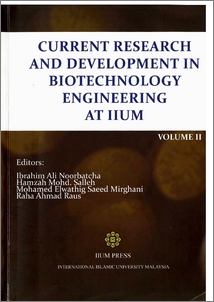Mohamad Puad, Noor Illi and Farouk, Abd Alaziem and Salleh, Hamzah Mohd.
(2011)
Effects of cell immobilization to the phytate-degrading enzyme activity.
In:
Current Research and Development in Biotechnology Engineering at IIUM (volume II).
IIUM Press, Kuala Lumpur, pp. 137-143.
ISBN 978-967-418-151-2
![[img]](http://irep.iium.edu.my/style/images/fileicons/application_pdf.png)  Preview |
|
PDF (Effects of Cell Immobilization to the Phytate-Degrading Enzyme Activity )
- Published Version
Download (585kB)
| Preview
|
Abstract
The use of immobilized whole microhial cells and/or organelles eliminates lhc often tedious. lime consuming. and expensi\'e sleps invohed in isolation and purificatioll of imraccllular enzymes. II al>o lends 10 enhance the stability of lhe enzyme by relaining its nall.....l catalytic surroundings during immobilizalion and subsequent cominuous operalion. A baclerium isolated from
Malaysian waslewatn pnxlucing a 1l0,-e1 phyrate-degrading enzyme namely PhyFAUIAI was immobilized in alginate gel beads. PhyFAUIA 1 is a periplasmatic enzyme and highly substralespecific 10 phytale. The enzyme aClivity wa~ invesligaled upon cell immobilization. No shift in
pH oplima of phytase of immobilized cells was obsen·ed. 110wever. the optimum lcmperaturcbwas shifted 10 50°C, which was 15°C lower lhan free PhyFAUIAI enzyme. Immobilized cells were found 10 be more stable in wider range of pll and tcmpe-ramr.: compared to free cells. The
results presenled in this work show lhe potential for using immobilized cells to produce ditrerent "~nJ-inosilOl phosphates intennediales
Actions (login required)
 |
View Item |


 Download Statistics
Download Statistics Download Statistics
Download Statistics